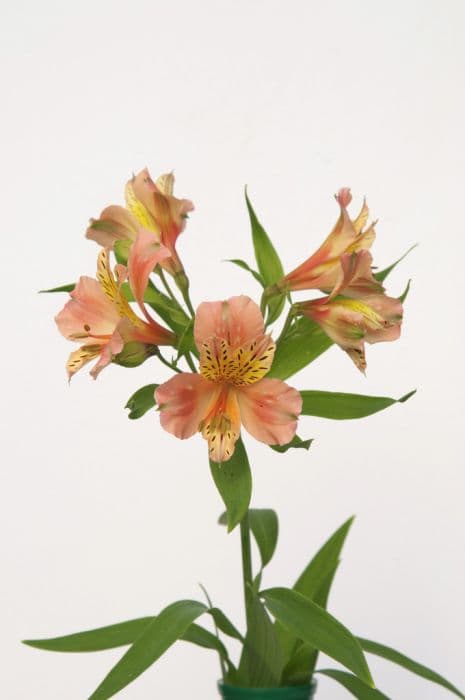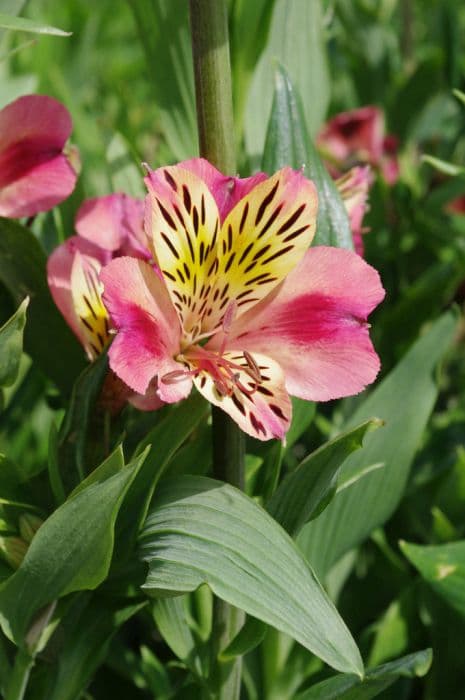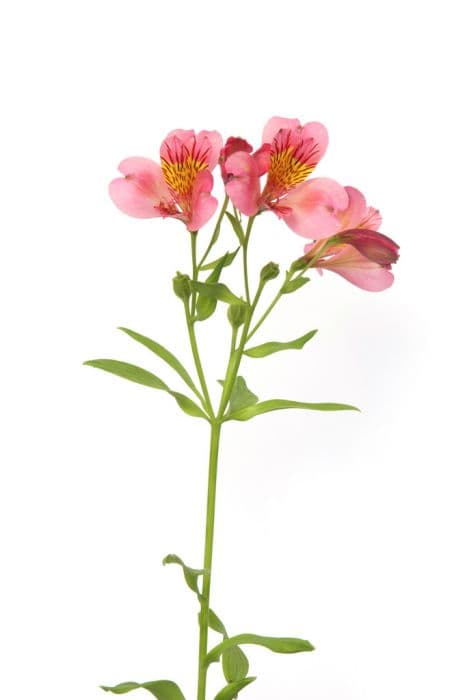Peruvian lily [Rock 'n' Roll] Alstroemeria Rock 'n' Roll = 'Alsdun01' (PBR) (v)
![Peruvian lily [Rock 'n' Roll]](/_next/image?url=https%3A%2F%2Fplants-admin.emdemapps.com%2Fimages%2Fplants%2F%2Fimages%2F604b54e536655.png&w=3840&q=75)
ABOUT
[Rock 'n' Roll] is a clump-forming perennial, to 1m in height, with lance-shaped, variegated leaves of white edged with green. In spring, new shoots are yellow. Throughout summer and autumn dark red flowers contrast well with the foliage and the white flower stems
About this plant
 Names
NamesSynonyms
Peruvian Lily, Lily of the Incas, Parrot Lily.
Common names
Alstroemeria Rock 'n' Roll = 'Alsdun01' (PBR) (v).
 Characteristics
CharacteristicsLife cycle
Perennials
Foliage type
Deciduous
Color of leaves
Variegated
Flower color
Mixed
Height
2 feet (60 cm)
Spread
2 feet (60 cm)
Plant type
Herb
Hardiness zones
7
Native area
South America
Benefits
 General Benefits
General Benefits- Long-lasting blooms: The Alstroemeria, also known as the Peruvian Lily, is prized for its prolonged flowering period, which can last from late spring through fall.
- Vibrant colors: Rock 'n' Roll Alstroemerias have distinctive, brightly colored flowers that can add vibrancy to any garden or bouquet.
- Good cut flowers: These flowers have a good vase life, making them popular choices for floral arrangements and bouquets.
- Drought tolerance: Once established, Alstroemerias such as Rock 'n' Roll have moderate drought tolerance, reducing the need for frequent watering.
- Attracts pollinators: They attract bees, butterflies, and hummingbirds, supporting local ecosystems and aiding in pollination of surrounding plants.
- Low maintenance: They generally require minimal upkeep beyond the first year of planting, making them a convenient choice for gardeners of any skill level.
- Cold hardy: Alstroemeria Rock 'n' Roll is relatively resistant to cooler temperatures, which allows it to be grown in a variety of climates.
 Medical Properties
Medical PropertiesThis plant is not used for medical purposes.
 Air-purifying Qualities
Air-purifying QualitiesThis plant is not specifically known for air purifying qualities.
 Other Uses
Other Uses- Plant dye: The petals of the Peruvian Lily can be used to create natural dyes for fabric or paper, imparting delicate colors.
- Photography: The striking contrasting colors of the Peruvian Lily make it a popular subject for botanical photographers and hobbyists.
- Educational tool: The Peruvian Lily's unique structure can be used in schools or educational programs to teach about plant biology and hybridization.
- Artistic inspiration: Artists may use the vivid patterns of the Peruvian Lily as inspiration for paintings, textiles, or other visual art pieces.
- Crafts: Dried petals of the Peruvian Lily can be incorporated into homemade paper or used in potpourri mixes for a splash of color and mild fragrance.
- Culinary decoration: Though not commonly eaten, petals can garnish salads or desserts for a decorative touch (ensure the variety is non-toxic and pesticide-free before use).
- Markers of seasonal change: Hobbyist gardeners might use the flowering of the Peruvian Lily as indicators of seasonal changes in a climate observation journal.
- Event décor: Because they are long-lasting, Peruvian Lilies can be used in floral arrangements for events such as weddings or formal gatherings.
- Memory gardens: As a perennial with personal significance, a Peruvian Lily can be planted in memory of a loved one or a special event.
- Traditional ceremonies: In certain cultures, flowers like the Peruvian Lily may be incorporated into ceremonies or rituals based on their color symbolism or availability.
Interesting Facts
 Feng Shui
Feng ShuiThe Peruvian Lily is not used in Feng Shui practice.
 Zodiac Sign Compitability
Zodiac Sign CompitabilityThe Peruvian Lily is not used in astrology practice.
 Plant Symbolism
Plant Symbolism- Friendship: Alstroemeria, also known as Peruvian Lily or Lily of the Incas, is often associated with deep bonds and devoted friendship due to its interlocking leaves which represent interconnectedness.
- Wealth, Prosperity, and Fortune: Because of the bountiful petals on each flower and its lush appearance, the Peruvian Lily is known to symbolize abundance and wealth.
- Devotion: The intricate patterns on the petals symbolize the complexity and endurance of commitment, making them a symbol of mutual support and steadfastness.
- Achievement of Aspirations: The upward growth and reaching nature of the Peruvian Lily often represents progression and growth, symbolizing the pursuit and achievement of personal goals.
 Water
WaterPeruvian lilies, including Alstroemeria 'Rock 'n' Roll', prefer consistent moisture but do not like to be water-logged. It's best to water them deeply once a week, ensuring that the soil is moist to a depth of several inches. During particularly hot or dry spells, you may need to water them more frequently, possibly every few days. You should provide 1 to 2 gallons of water per plant each time you water, depending on the size of the plant and the environmental conditions. Always avoid overhead watering to minimize the risk of fungal diseases, and focus on watering at the base of the plant.
 Light
LightPeruvian lilies thrive in full sun to partial shade, meaning Alstroemeria 'Rock 'n' Roll' should ideally receive at least six hours of direct sunlight a day. If planted outdoors, an east-facing garden that gets morning light or a spot that has dappled shade in the afternoon is ideal. Indoor plants should be placed near a bright window where they can get ample light without being exposed to harsh midday sun.
 Temperature
TemperaturePeruvian lilies such as Alstroemeria 'Rock 'n' Roll' prefer temperatures between 65 to 80 degrees Fahrenheit. They can tolerate a minimum temperature of around 50 degrees Fahrenheit and can survive up to about 90 degrees Fahrenheit but thrive in the moderate range. These plants do not fare well in temperatures that consistently exceed their maximum tolerance or drop below their minimum threshold for prolonged periods.
 Pruning
PruningPeruvian lilies, or Alstroemeria 'Rock 'n' Roll', should be pruned to remove faded flowers and dead foliage, which encourages further blooming and maintains the plant's appearance. Prune the spent stalks down to the ground level after the blooms fade. This can be done throughout the blooming season, typically from late spring to early fall, to keep the plant healthy and promote continuous flowers.
 Cleaning
CleaningAs needed
 Soil
SoilFor Peruvian Lily 'Rock 'n' Roll', a well-draining soil mix, rich in organic matter is ideal. A blend of two parts loam, one part peat or compost, and one part sharp sand or perlite will encourage healthy growth. The soil pH should be slightly acidic to neutral, ranging from 6.0 to 7.0. Regularly amending the soil with organic matter will help maintain its structure and fertility.
 Repotting
RepottingPeruvian Lilies typically require repotting every two to three years to refresh the soil and accommodate the growth of their tuberous root system. They should be repotted in the spring or after flowering when they are less actively growing. Use the opportunity to divide clumps if necessary to propagate or manage their size.
 Humidity & Misting
Humidity & MistingPeruvian Lily prefers moderate humidity levels. They thrive in an environment with 40-60% humidity, which is similar to typical indoor conditions. However, they can tolerate lower humidity levels without much trouble, as long as they are adequately watered and not in a dry, drafty area.
 Suitable locations
Suitable locationsIndoor
Place in bright, indirect light; avoid full sun.
Outdoor
Plant in partial shade with morning sun and shelter.
Hardiness zone
7-10 USDA
 Life cycle
Life cycleThe life cycle of Alstroemeria 'Rock 'n' Roll' begins with seed germination, where the seed develops into a seedling under appropriate conditions of temperature and moisture. It then enters a vegetative stage, growing leaves and stems as it establishes a root system. Once mature, it starts the reproductive stage by producing unique, colorful flowers that attract pollinators, necessary for the cross-pollination required for seed production. After pollination, the flowers develop into capsules containing seeds, which eventually dry and release the seeds, continuing the cycle. During its yearly cycle, this perennial may enter a dormancy phase in response to colder temperatures, reducing above-ground growth to conserve energy. With the return of favorable growth conditions, Alstroemeria 'Rock 'n' Roll' regenerates from its rhizomes to begin the cycle anew.
 Propogation
PropogationPropogation time
Spring to Summer
The Alstroemeria Rock 'n' Roll, commonly known as Peruvian Lily or Lily of the Incas, is frequently propagated through division, which is the most popular method for this specific cultivar. This process is typically undertaken in the spring or early summer when the plant is emerging from dormancy and can recover quickly. To propagate by division, the plant should be carefully lifted from the soil and the rootball divided into sections, each with two or three shoots and a portion of the root system. These sections can then be replanted into well-drained soil, ensuring that they are set at the same depth as they were previously growing. It is essential to water the new divisions thoroughly to help establish the root system, taking care not to saturate the soil. This method allows the gardener to create new plants that are genetically identical to the parent, thus retaining all the desirable characteristics of the Alstroemeria Rock 'n' Roll variety.




![Peruvian lily [H.R.H. Princess Alice]](/_next/image?url=https%3A%2F%2Fplants-admin.emdemapps.com%2Fimages%2Fplants%2F%2Fimages%2F604b55e81c8b0.png&w=640&q=75)
![Peruvian lily [Indian summer]](/_next/image?url=https%3A%2F%2Fplants-admin.emdemapps.com%2Fimages%2Fplants%2F%2Fimages%2F604b616bc746b.png&w=640&q=75)
![Peruvian lily [Inticancha Creamy Dark Pink]](/_next/image?url=https%3A%2F%2Fplants-admin.emdemapps.com%2Fimages%2Fplants%2F%2Fimages%2F604b5e98bea7c.png&w=640&q=75)
![Peruvian lily [Inticancha Dark Purple]](/_next/image?url=https%3A%2F%2Fplants-admin.emdemapps.com%2Fimages%2Fplants%2F%2Fimages%2F604b5381bb78f.png&w=640&q=75)
![Peruvian lily [Inticancha Imala]](/_next/image?url=https%3A%2F%2Fplants-admin.emdemapps.com%2Fimages%2Fplants%2F%2Fimages%2F604b619b522ba.png&w=640&q=75)
![Peruvian lily [Inticancha Red]](/_next/image?url=https%3A%2F%2Fplants-admin.emdemapps.com%2Fimages%2Fplants%2F%2Fimages%2F604b5aebac273.png&w=640&q=75)